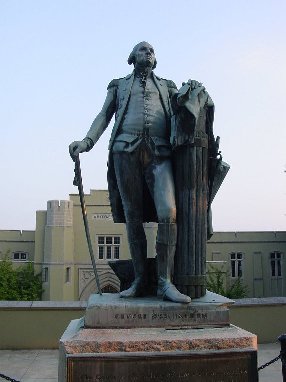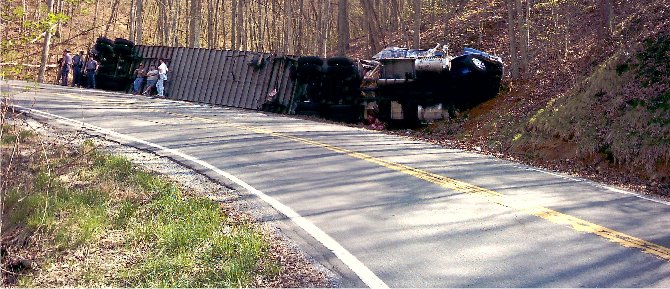Hunter's Raid
(or the Lynchburg Campaign)
May 26, 1864 to June 23, 1864
After the battle at New Market, Breckinridge and most of his victorious Confederate troops were sent to help protect Richmond, so the Shenandoah Valley was defended only by cavalry. Meanwhile, Union forces in the Valley were reorganized and placed under the command of Gen. David Hunter. Hunter was a fanatical abolitionist, and he would destroy anything that could be of use to the Confederacy. His orders were so harsh, many of his own troops would refuse to comply. Hunter's objectives were Staunton and Lynchburg, which were essential for the protection of Richmond.
On May 26, 1864, Hunter's 11,000 infantry and 5,000 cavalry left Strasburg headed for Staunton, the Valley's major rail center, intending to live off the land and carrying only a few days supply of food. Gen. Crook's men were now at Lewisburg, West Virginia after returning from the southwest Virginia raid that climaxed at Cloyds Mountain. Starting on May 31st, Crook advanced on Staunton through Covington. Confederate Gen. McCausland delayed Crook, while Imboden's cavalry delayed Hunter's column. Gen. William E. "Grumble" Jones was in charge of Confederate forces in southwest Virginia and now assumed command in the Valley. Jones moved the troops that had just fought at Cloyds Mountain into the Shenandoah Valley, eventually scraping together a force of 3,500 infantry and 5,000 cavalry. Jones moved into a strong defensive position near Harrisonburg several miles north of Staunton. Instead of attacking this position, Hunter outflanked it to the east, passing through Port Republic and then heading south. Jones detached some additional troops to hold off Crook and moved with his remaining 5,000 men to block Hunter's advance. The Confederate troops crossed the Middle River and took up position near the town of Piedmont. On June 5, 1864, Hunter's men made contact.
Piedmont June 5, 1864
Confederate cavalry under Imboden skirmished with Hunter's men north of Piedmont. This bought time for Jones to position his infantry behind a rail fence on a hill north of town. His left was protected by the Middle River. To the right of the infantry, a gap was open between the infantry and the dismounted cavalry to their right rear.
This picture is the view from the gap. Off the picture to the left is the Rebel infantry. On the far right is a house marking the East Road heading into the Confederate rear. The white silo on the right is the approximate position of the dismounted cavalry under Imboden and Vaughn, positioned to protect the flank. Because Jones feared another Federal turning movement, pickets were sent out as far as the round hill on the far right of the picture. The Blue Ridge mountains are in the distance.
Hunter's Yankees deployed against the Rebel infantry line. Union artillery began a bombardment at 9A.M. and neutralized Confederate artillery by 11:30. Federal assaults gained some ground but gained no decisive advantage. Hunter then ordered the 34th Massachusetts and the 54th Pennsylvania to move off the main line and join part of the 1st New York Cavalry. This group of men, under Col. Thoburn, moved into the valley on the left of the picture to the area around the blue silo visible in the picture. These Federals deployed to attack through the gap to the right of the Confederate infantry line. At the time this area was wooded. Dismounted Rebel cavalry directly faced this dangerous threat and the men were eager to attack, but Imboden and Vaughn interpreted their orders strictly and stayed put. The weakened Union main line was now under serious pressure, and Hunter ordered his wagon trains to withdraw as a precaution.
A Confederate battery fired on Thoburn's men, forcing them to halt. Jones saw the threatening Federal force, but he ordered the battery to move their fire toward the Union main line. Thoburn's men now moved forward through the gap and into the 60th Virginia on the Rebel right flank. Desperate fighting ensued for half an hour in which Jones was killed. The main Confederate line was in the process of withdrawing to a position next to the cavalry, and the Federal flank attack along with Jones' death turned confusion into panic.
The Rebels were swept from the field and Union cavalry pursued. One thousand Confederates surrendered and 600 hundred had been killed or wounded. Hunter suffered 780 casualties. The next day, June 6, Staunton fell to the Yankees.
In retrospect, it is clear that Hunter should have forced his way across the Blue Ridge and taken Charlottesville and Gordonsville. This would have given him a good rail supply line to advance on Lynchburg. However, after his victory at Piedmont, Hunter learned of Sheridan's Trevilian Station Raid. With the Army of the Potomac stalemated in front of Richmond, Grant sent Sheridan northwest toward Charlottesville. Sheridan was to divert Lee's attention while the Army of the Potomac crossed the James River and attacked Petersburg. Sheridan intended to link up with Hunter at Charlottesville and join him in marching on Lynchburg - then Richmond.
 |
|
 |
|

Buchanan June 13, 1864
Also on June 11th, Sheridan was defeated at Trevilian's Station, leaving Hunter to fend for himself. Hunter continued south and reached Buchanan on June 13th. McCausland and his approximately 1,500 men briefly made a stand here. Shown in the picture are the bridge abutments of the covered bridge that spanned the James. McCausland and a Cpt. St. Clair had had hay and oil brought to the bridge in order to burn it. McCausland himself lit the fire, but the Yankees were approaching fast and the two men were on the wrong side of the bridge. St. Clair tried to escape along the bank but was captured. McCausland jumped off the burning bridge and swam to a small boat which he then paddled to safety. McCausland's artillery briefly took up position on the hill visible in the background and the Federals bombarded the town briefly. The fire from the bridge started a few fires in Pattonsburg on the north side of the river. When the Federals found a ford upstream, the Confederates abandoned town and headed over the Blue Ridge at the Peaks of Otter.
The same day as this skirmish, Jubal Early and the 8,000 survivors of his Second Corps started the move from Cold Harbor to Lynchburg. Since Sheridan's expedition had failed, and since Hunter's cavalry had failed to cut the rail line to Lynchburg, Early had an open route to Lynchburg. If Hunter was to capture Lynchburg, time was of the essence. He had already wasted several days in Staunton and Lexington. Any more delays could be fatal.


Modern Rt 43 Up to the Peaks of Otter
The Confederates retreated up what is today Route 43 to Peaks of Otter, felling trees and creating landslides. The road is still quite treacherous today. In recent times a car has run off the side only to be found months later with a decomposed body. Truckers trying to use the shortcut shown on their computers regularly get stuck or crash in the sharp curves. In the early to mid 1990s, the Tour du Pont descended this mountain, and it is still popular with local cyclists like my brother, shown here on the above photo, and I, who either test their descending skills or tackle the challenge of a steep 1,400 foot climb. (It's another 600 feet of climb to go to all the way to the Peaks.) Clearly, this was not a good route for a Civil War army.
Back to Civil War Virtual Battlefield Tours
Continue to Hunter's Raid Part 2